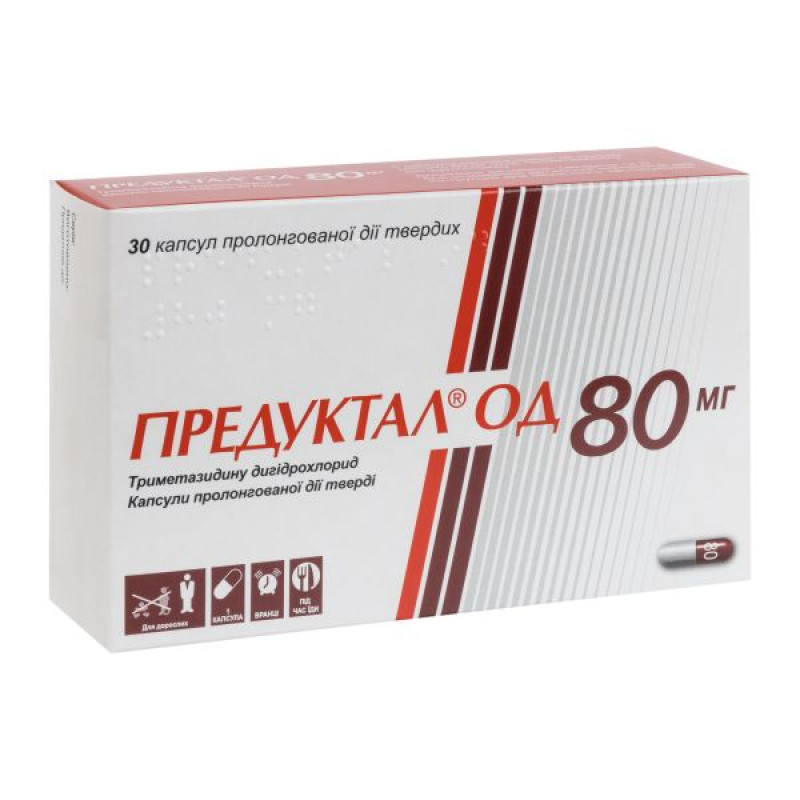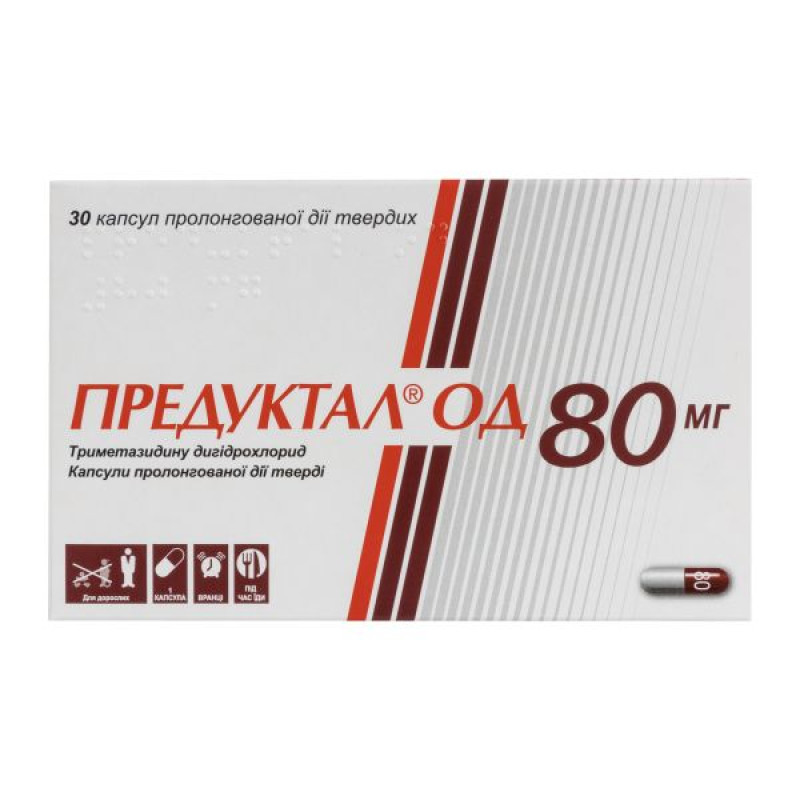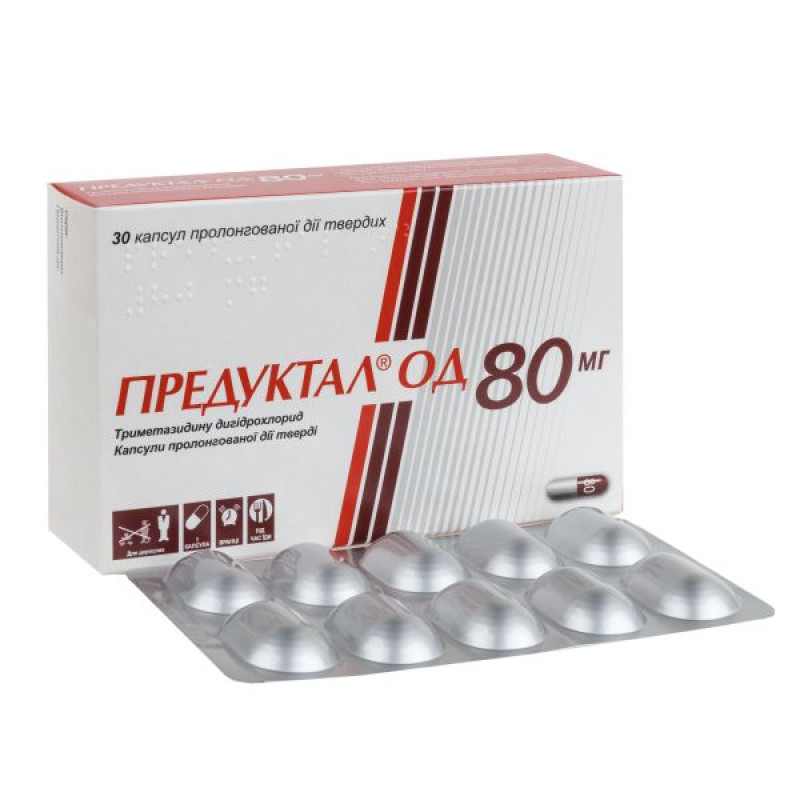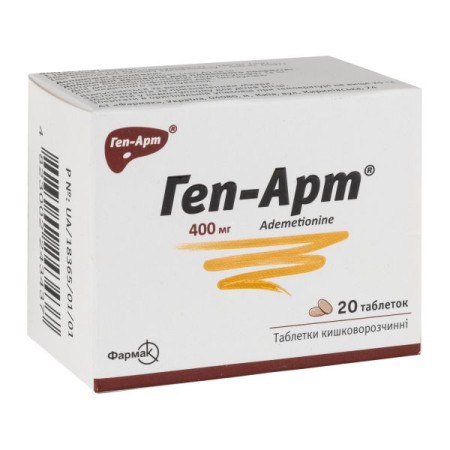Preductal OD 80 mg prolonged-release capsules No. 30

Instructions for Preductal OD 80 mg prolonged-release capsules No. 30
Composition
active ingredient: trimetazidine;
Preductal® OD 40 mg
1 extended-release hard capsule contains 40 mg of trimetazidine dihydrochloride;
excipients: spherical sugar*, hypromellose, ethyl cellulose, acetyl tributyl citrate, talc, magnesium stearate;
capsule shell: titanium dioxide (E 171), gelatin; ink: shellac (E 904), propylene glycol (E 1520), concentrated ammonia solution (E 527), potassium hydroxide (E 525), titanium dioxide (E 171), black iron oxide (E 172);
Preductal® OD 80 mg
1 extended-release hard capsule contains 80 mg of trimetazidine dihydrochloride;
excipients: spherical sugar*, hypromellose, ethyl cellulose, acetyl tributyl citrate, talc, magnesium stearate;
capsule shell: titanium dioxide (E 171), gelatin, red iron oxide (E 172); ink: shellac glaze – 45% (20% esterified) in ethanol, titanium dioxide (E 171), simethicone, propylene glycol (E 1520), ammonium hydroxide 28% (E 527).
* Spherical sugar (710–850 μm) contains sucrose and corn starch
Medical form
The extended-release capsules are hard.
Main physicochemical properties:
Preductal® OD 40 mg: white capsules, size 3, containing spherical, coated granules, white or almost white in color, with the company logo and the inscription "40" printed on the capsule cap in gray ink.
Preductal® OD 80 mg: size 2 capsules with a white body and an orange-red cap, containing spherical, coated granules of white or almost white color, with the company logo and the inscription "80" printed on the capsule cap in white ink.
Pharmacotherapeutic group
Cardiological drugs. Trimetazidine. ATC code C01E B15.
Pharmacological properties
Pharmacodynamics.
Mechanism of action
By preserving energy metabolism in cells suffering from hypoxia or ischemia, trimetazidine prevents a decrease in intracellular ATP levels, thereby ensuring the proper functioning of ion pumps and transmembrane sodium-potassium flux while maintaining cellular homeostasis.
Trimetazidine inhibits β-oxidation of fatty acids by blocking long-chain 3-ketoacyl-CoA thiolase (3-CAT), which increases glucose oxidation. In cells under ischemic conditions, the process of obtaining energy through glucose oxidation requires less oxygen compared to the process of obtaining energy through β-oxidation of fatty acids. The enhancement of the glucose oxidation process optimizes energy processes in cells, and accordingly, maintains sufficient energy metabolism under ischemic conditions.
Pharmacodynamic effects
In patients with ischemic heart disease, trimetazidine acts as a metabolic agent, maintaining intracellular levels of high-energy phosphates in the myocardium. Anti-ischemic effects are achieved without concomitant hemodynamic effects.
Clinical efficacy and safety
Clinical studies have demonstrated the efficacy and safety of trimetazidine for the treatment of patients with stable angina both as monotherapy and when added to other antianginal drugs when they are insufficiently effective.
A randomized, double-blind, placebo-controlled study (TRIMPOL-II) in 426 patients demonstrated that the addition of trimetazidine 60 mg daily to metoprolol 100 mg (50 mg twice daily) for 12 weeks resulted in significant improvements in exercise test performance and clinical symptoms compared to placebo: total exercise duration - +20.1 s, p=0.023; total work performed - +0.54 MET s, p=0.001; time to 1 mm ST-segment depression - +33.4 s, p=0.003; time to angina attack - +33.9 s, p<0.001; number of angina attacks/week - -0.73, p=0.014; use of short-acting nitrates/week - -0.63, p=0.032, without changes in hemodynamic parameters.
In a randomized, double-blind study (Vasco study) of 1962 patients, which lasted 3 months, trimetazidine 70 mg/day or 140 mg/day or placebo was added to atenolol 50 mg/day. In the overall population, which included patients with and without symptoms, trimetazidine did not show any benefit in terms of either ergometric parameters (total exercise time, time to 1 mm ST-segment depression and time to angina attack) or clinical endpoints. However, in a subgroup of symptomatic patients (n=1574), trimetazidine 140 mg/day significantly improved total exercise time (+23.8 s vs. +13.1 s placebo; p=0.001) and time to angina attack (+46.3 s vs. +32.5 s placebo; p=0.005).
A randomized, double-blind, tolerability study in 165 patients, lasting 3 months, demonstrated that the safety profile of trimetazidine 80 mg once daily, both in routine antianginal therapy and secondary prevention therapy, was similar to that of trimetazidine MR 35 mg twice daily. No unexpected adverse reactions were reported, and the study demonstrated the absence of any safety concerns associated with a single dose of trimetazidine 80 mg.
Pharmacokinetics.
Absorption
After oral administration of trimetazidine capsules 80 mg, the pharmacokinetic profile of trimetazidine is uniform, the maximum concentration of trimetazidine is reached approximately 14 hours after taking the drug. During the interdose interval (24 hours), the plasma concentration remains at a level of at least 75% of the maximum concentration for 15 hours. Stable concentration is achieved after taking the third dose (3 days).
Food intake does not affect the pharmacokinetic characteristics of trimetazidine.
Distribution
The volume of distribution is 4.8 l/kg; protein binding is low (16%).
Breeding
Trimetazidine is excreted mainly in the urine, mainly unchanged. The half-life is on average 7 hours in healthy young volunteers and 12 hours in elderly subjects (65 years and older). The complete elimination of trimetazidine is mainly the result of renal clearance, which correlates with creatinine clearance, and to a lesser extent is the result of hepatic clearance, which decreases with age.
Special categories of patients
Elderly patients. Elderly patients may experience increased trimetazidine concentrations due to age-related decline in renal function. A specific pharmacokinetic study in patients aged 75–84 years or ≥ 85 years showed that in patients with moderate renal impairment (creatinine clearance 30–60 ml/min) trimetazidine concentrations increased 1.0 and 1.3 times, respectively, compared to younger patients (aged 30–65 years) with moderate renal impairment. A specific clinical study in elderly patients (75 years and older) using trimetazidine MR 35 mg (1 tablet) twice daily, with population kinetic analysis, showed an average 2-fold increase in plasma concentrations in patients with severe renal impairment (creatinine clearance < 30 ml/min) compared to patients with creatinine clearance > 60 ml/min. No safety concerns were observed in this population compared to the general population.
Renal impairment: Trimetazidine blood concentrations increased on average 1.7-fold in patients with moderate renal impairment (creatinine clearance 30–60 mL/min) and on average 3.1-fold in patients with severe renal impairment (creatinine clearance < 30 mL/min) compared to healthy volunteers with normal renal function. No safety concerns were observed in this population compared to the general population.
Children: The pharmacokinetics of trimetazidine have not been studied in patients under 18 years of age.
Indication
In adults, trimetazidine is indicated for the symptomatic treatment of stable angina pectoris when first-line antianginal drugs are ineffective or intolerant.
Contraindication
- Hypersensitivity to the active substance or to any of the excipients of the drug.
- Parkinson's disease, parkinsonism symptoms, tremor, restless legs syndrome and other movement disorders related to the above.
- Severe renal impairment (creatinine clearance < 30 ml/min).
Interaction with other medicinal products and other types of interactions
Not detected.
Application features
This medicinal product is not intended for the relief of angina attacks. It should not be prescribed as primary therapy in the pre-hospital stage or in the first days of hospitalization for unstable angina or myocardial infarction.
In the event of an attack of unstable angina during current therapy, it is necessary to review the patient's course of the disease and adjust the treatment (drug therapy and the possibility of revascularization).
If movement disorders appear, such as symptoms of parkinsonism, restless legs syndrome, tremor, gait instability, trimetazidine should be discontinued.
Movement disorders are rare and usually resolve after discontinuation of treatment. In most patients, these symptoms resolved within 4 months of discontinuation of trimetazidine. If parkinsonism symptoms persist for more than 4 months after discontinuation of the drug, a neurologist should be consulted.
Falls associated with gait instability or hypotension may occur, especially in patients receiving antihypertensive treatment (see section "Adverse reactions").
Trimetazidine should be prescribed with caution to patients at risk of increased concentrations:
- patients with moderate renal impairment (see sections “Method of administration and dosage” and “Pharmacokinetics”);
- elderly patients aged 75 years and over (see section "Method of administration and dosage").
This medicinal product contains sucrose. Patients with rare hereditary problems of fructose intolerance, glucose-galactose malabsorption or sucrase-isomaltase insufficiency should not take this medicinal product.
Athletes: This medicine contains an active substance that may produce a positive result in an anti-doping test.
Use during pregnancy or breastfeeding
Pregnancy
There are no data on the use of trimetazidine in pregnant women. Animal studies do not indicate direct or indirect harmful effects with respect to reproductive toxicity. In order to avoid any risk, trimetazidine is not recommended for use during pregnancy.
Breast-feeding
It is not known whether trimetazidine is excreted in human milk. A risk to the newborn/infants cannot be excluded. Trimetazidine should not be used during breast-feeding.
Fertility
Reproductive toxicity studies showed no effect on the fertility of female and male rats.
Ability to influence reaction speed when driving vehicles or other mechanisms
According to clinical studies, trimetazidine does not affect hemodynamics, however, in the post-marketing period, cases of dizziness and drowsiness were recorded (see section "Adverse reactions"), which may affect the ability to drive a car and work with other mechanisms.
Method of administration and doses
For oral use.
The recommended dose is 1 capsule of trimetazidine 80 mg once a day in the morning during breakfast. The capsules should be taken unopened and washed down with water.
After 3 months of treatment, the results of treatment should be evaluated and in the absence of a response to treatment, trimetazidine should be discontinued.
Special categories of patients
Kidney dysfunction
Patients with moderate renal impairment (creatinine clearance 30-60 ml/min) (see sections 4.4 and 5.2) should have their dose halved. The recommended dose is 1 capsule of trimetazidine 40 mg or 1 tablet of trimetazidine 35 mg in the morning with breakfast.
Elderly patients
In elderly patients, an increase in the concentration of trimetazidine in the blood is possible due to age-related decline in renal function (see section "Pharmacokinetics"). Patients with moderate renal impairment (creatinine clearance - 30-60 ml / min) should reduce the dose by half. The recommended dose is 1 capsule of trimetazidine 40 mg or 1 tablet of trimetazidine 35 mg in the morning during breakfast.
Elderly patients should be titrated with caution (see section "Special warnings and precautions for use").
Children
The safety and efficacy of trimetazidine in children under the age of 18 have not been established. Data are lacking.
Overdose
There is limited data on overdose with trimetazidine. Treatment should be symptomatic.
Adverse reactions
Adverse reactions that have been identified as possible adverse reactions related to the use of trimetazidine are listed below according to the frequency assigned: very common (≥ 1/10); common (≥ 1/100, < 1/10); uncommon (≥ 1/1000, < 1/100); rare (≥ 1/10000, < 1/1000); very rare (< 1/10000); frequency unknown (cannot be estimated from the available data).
| Classification by organ systems | Frequency | Adverse reaction |
| From the nervous system | Often | Dizziness, headache |
| Frequency unknown | Parkinsonism symptoms (tremor, akinesia, muscle hypertonia), gait instability, restless legs syndrome and other movement disorders related to the above, which usually resolve after discontinuation of treatment | |
| Sleep disorders (insomnia, drowsiness) | ||
| From the side of the organs of hearing and vestibular apparatus | Frequency unknown | Vertigo |
| From the heart | Rarely | Palpitations, extrasystole, tachycardia |
| From the vascular side | Rarely | Hypotension, orthostatic hypotension, which may be associated with malaise, dizziness or fall, especially in patients taking antihypertensive drugs, facial flushing |
| Gastrointestinal tract | Often | Abdominal pain, diarrhea, dyspepsia, nausea and vomiting |
| Frequency unknown | ||
| Skin and subcutaneous tissue disorders | Often | Rash, itching, hives |
| Frequency unknown | Acute generalized exanthematous pustulosis, angioedema | |
| General disorders | Often | Asthenia |
| Blood and lymphatic system disorders | Frequency unknown | Agranulocytosis, thrombocytopenia, thrombocytopenic purpura |
| Hepatobiliary system | Frequency unknown | Hepatitis |
Report of suspected adverse reactions
Reporting suspected adverse reactions during the post-marketing period is important to allow for continuous monitoring of the benefit/risk balance of the drug.
Healthcare professionals are required to report any suspected adverse reactions through the national reporting system.
Expiration date
3 years.
Storage conditions
Does not require any special storage conditions. Keep out of the reach of children.
Packaging
10 capsules in a blister of polyamide-aluminum-PVC foil and aluminum foil; 3 or 9 blisters in a cardboard box.
Vacation category
According to the recipe.
Producer
CJSC Pharmaceutical Plant EGIS / EGIS Pharmaceuticals Plc.
Location of the manufacturer and address of its place of business
1165, Budapest, Bokenyfoldi ut 118-120., Budapest, 1165, Hungary.
Applicant
LE LABORATORIES SERVIER / Les Laboratoires Servier.
Applicant's location
50, rue Carnot, 92284 Suresnes Сedex, France / 50, rue Carnot, 92284 Suresnes Сedex, France.
There are no reviews for this product.
There are no reviews for this product, be the first to leave your review.
No questions about this product, be the first and ask your question.













